

 |
Search the Site with

|
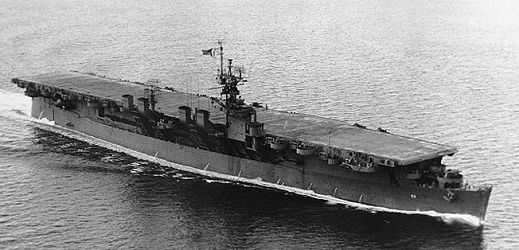 | Sorry, no coat of arms available. |
USS PRINCETON was the second INDEPENDENCE - class light aircraft carrier and the fourth ship in the Navy to bear the name. Like the other ships in her class, the PRINCETON was originally laid down as a light cruiser but following the attack on Pearl Harbor, Hi., the Navy had an urgent need for more aircraft carriers. Therefore, a few of the light cruisers under construction at that time were reordered as aircraft carriers.
On October 24, 1944, USS PRINCETON was attacked by a Japanese dive bomber causing her bomb magazine to explode. The after part of the PRINCETON was wrecked and severe casualties inflicted on the crew of USS BIRMINGHAM (CL 62), which was alongside helping to fight the fires. After her remaining crewmen were removed, USS PRINCETON was sunk by her escorts.
| General Characteristics: | Awarded: 1940 (as light cruiser), 1942 (as aircraft carrier) |
| Keel laid: June 2, 1941 | |
| Launched: October 18, 1942 | |
| Commissioned: February 25, 1943 | |
| Sunk: October 24, 1944 | |
| Builder: New York Shipbuilding, Camden, N.J. | |
| Propulsion system: geared turbines, 100,000 shp | |
| Propellers: two | |
| Length: 623 feet (189.9 meters) | |
| Beam: 71.5 feet (21.8 meters) | |
| Draft: 25.9 feet (7.9 meters) | |
| Displacement: approx. 11,000 tons standard | |
| Speed: 31.5 knots | |
| Aircraft: 34 | |
| Catapults: two | |
| Aircraft Elevators: two | |
| Armament: 26 x 40mm guns, 22 x 20mm guns | |
| Crew: approx. 1560 |
Crew List:
This section contains the names of sailors who served aboard USS PRINCETON. It is no official listing but contains the names of sailors who submitted their information.
USS PRINCETON History:
USS PRINCETON was laid down as TALLAHASSEE (CL 61) by the New York Shipbuilding Corp., Camden, N.J., 2 June 1941; reclassified CV 23 on 16 February 1942; renamed PRINCETON 31 March 1942; launched 18 October 1942; sponsored by Mrs. Harold Dodds; and commissioned at Philadelphia 25 February 1943, Capt. George R. Henderson in command.
Following shakedown in the Caribbean, and reclassification to CVL 23 on 15 July 1943, PRINCETON, with Air Group 23 embarked, got underway for the Pacific. Arriving at Pearl Harbor 9 August, she sortied with TF 11 on the 25th and headed for Baker Island. There she served as flagship, TG 11.2 and provided air cover during the occupation of the island and the construction of an airfield there, 1-14 September. During that time her planes downed Japanese ďEmilyĒ reconnaissance planes and, more important, furnished the fleet with photographs of them.
Completing that mission, PRINCETON rendezvoused with TF 15, conducted strikes against enemy installations on Makin and Tarawa, then headed back to Pearl Harbor. In mid-October she sailed for Espiritu Santo where she joined TF 38 on the 20th. With that force she sent her planes against airfields at Buka and Bonis on Bougainville (1-2 November) to diminish Japanese aerial resistance during the landings at Empress Augusta Bay. On the 5th and 11th her planes raided Rabaul and on the 19th, with TF 50, helped neutralize the airfield at Nauru. PRINCETON then steamed northeast, covered the garrison groups enroute to Makin and Tarawa, and after exchanging operational aircraft for damaged planes from other carriers got underway for Pearl Harbor and the west coast.
Availability at Bremerton followed and on 3 January 1944 PRINCETON steamed west. At Pearl Harbor she rejoined the fast carriers of TF 50, now designated TF 58. On the 19th she sortied with TG 58.4 for strikes at Wotie and Taroa (29-31 January) to support amphibious operations against Kwajalein and Majuro. Her planes photographed the next assault target, Eniwetok, 2 February and on the 3rd returned on a more destructive assignment - the demolition of the airfield on Engebi. For 3 days the atoll was bombed and strafed. On the 7th PRINCETON retired to Kwajalein only to return to Eniwetok on the 10th -13th and 16th - 28th, when her planes softened the beaches for the invasion force, then provided air cover during the assault and ensuing fight.
From Eniwetok PRINCETON retired to Majuro, thence to Espiritu Santo for replenishment. On 23 March she got underway for strikes against enemy installation and shipping in the Carolines. After striking the Palaus, Woleai and Yap, the force replenished at Majuro and sortied again 13 April. Steaming to New Guinea, the carriers provided air cover for the Hollandia operation (21-29 April), then crossed back over the International Date Line to raid Truk (29-30 April) and Ponape (1 May).
On 11 May PRINCETON returned to Pearl Harbor only to depart again on the 29th for Majuro. There she rejoined the fast carriers and pointed her bow toward the Marianas to support the assault on Saipan. From 11-18 June she sent her planes against targets on Guam, Rota, Tinian, Pagan, and Saipan, then steamed west to intercept a Japanese fleet reported to be enroute from the Philippines to the Marianas. In the ensuing Battle of the Philippine Sea, PRINCETONís planes contributed 30 kills and her guns another 3, plus 1 assist, to the devasting toll inflicted on Japanís naval air arm.
Returning to the Marianas, PRINCETON again struck Pagan, Rota and Guam, then replenished at Eniwetok. On 14 July she got underway again as the fast carriers returned their squadrons to the Marianas to furnish air cover for the assault and occupation of Guam and Tinian. On 2 August the force returned to Eniwetok, replenished, then sailed for the Philippines. Enroute its planes raided the Palaus, then on 9-10 September struck airfields on northern Mindanao. On the 11th they pounded the Visayas. At mid-month the force moved back over the Pacific chessboard to support the Palauí offensive, then returned to the Philippines to hit Luzon, concentrating on Clark and Nichols fields. The force then retired to Ulithi and in early October bombed and strafed enemy airfields, installations and shipping in the Nansei Shoto and Formosa area in preparation for the invasion of the Philippines.
On the 20th, landings were made at Dulag and San Pedro Bay, Leyte. PRINCETON, in TG 38.3, cruised off Luzon and sent her planes against airfields there to prevent Japanese land based aircraft attacks on Allied ships massed in Leyte Gulf. On the 24th however enemy planes from Clark and Nichols fields found TG 38.3 and reciprocated. Shortly before 1000 a lone enemy dive-bomber came out of the clouds above PRINCETON. At 1500 feet the pilot released his bomb. It hit between the elevators, crashed through the flight deck and hangar, then exploded. Initial fires soon expanded as further explosions sent black smoke rolling off the flight deck and red flames along the sides from the island to the stern. Covering vessels provided rescue and fire-fighting assistance and shielded the stricken carrier from further attack. At 1524 another, much heavier explosion, possibly the bomb magazine, blew off the carrierís stern and with it the after flight deck. BIRMINGHAM (CL 62), alongside to fight fires, suffered heavy damage and casualties.
Efforts to save PRINCETON continued, but at 1604 the fires won. Boats were requested to take off remaining personnel and shortly after 1706 IRWIN (DD 794) began to fire torpedoes at the burning hulk. At 1746 RENO (CL 96) relieved IRWIN and at 1749 the last, and biggest, explosion occured. Flames and debris shot up 1000-2000 feet. PRINCETONís forward section was gone. Her after section appeared momentarily through the smoke. By 1750 she had disappeared, but 1,361 of her crew survived. Included in that number was Capt. John M. Hoskins, who had been prospective commanding officer of CVL 23 and lost his right foot with her, but who, despite the loss, would become the 1st commanding officer of the fifth PRINCETON (CV 37).
Losses and damage to assisting vessels were heavy: BIRMINGHAM - 85 killed, 300 wounded, a heavily damaged topside, and loss of 2 5-inch, 2 40mm and 2 20mm guns; MORRISON (DD 560) - foremast lost, portside smashed; IRWIN - forward 5-inch mounts and director out, starboardside smashed; and RENO - one 40mm gun smashed.
PRINCETON earned 9 battle stars during World War II.
USS PRINCETON Image Gallery:
 | 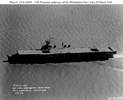 | 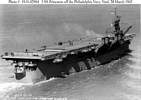 | 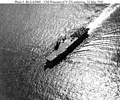 | 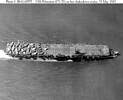 |
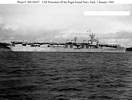 | 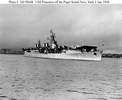 | 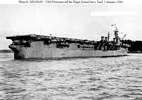 | 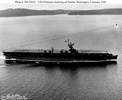 | 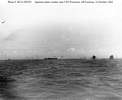 |
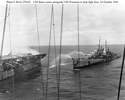 | 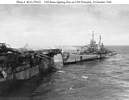 | 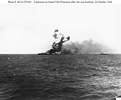 | 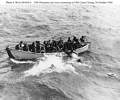 | 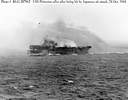 |
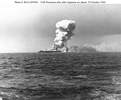 | 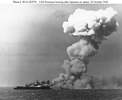 | 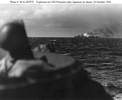 | 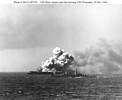 | 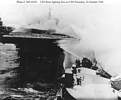 |
 Back to Light Aircraft Carriers list.
Back to Light Aircraft Carriers list.  Back to Ships list.
Back to Ships list.  Back to selection page.
Back to selection page.  Back to 1st page.
Back to 1st page.